Study on Evacuation Behavior of Urban Underground Complex in Fire Emergency Based on System Dynamics
Abstract
:1. Introduction
2. Literature Review
3. Materials and Methods
3.1. Analysis of Large-Scale Crowd Emergency Evacuation Accidents
3.2. System Dynamics Modeling Process
3.3. Model Setting
3.3.1. Scenario Setting
3.3.2. Staffing
3.4. Causality and Stock–Flow Diagrams
3.4.1. Construction of Causality Diagram
3.4.2. Construction of Stock–Flow Chart
- (1)
- State variable (level): The horizontal variable primarily indicates the system’s accumulation state during the dynamic change. It represents the accumulation of matter or energy (information) from the beginning to the end of a given period, and its magnitude is proportional to the rate variable.
- (2)
- Rate variable (rate): The state variable represents the accumulation over a given period, whereas the rate variable represents the state variable at a given point in time, i.e., the derivative.
- (3)
- Auxiliary variable (auxiliary): The primary function of the auxiliary variable is to complete the system structure. It is commonly used to supplement and enrich the logical relationship between the state and rate variables, i.e., the intermediate variable, to make the two more reasonable. A connection is also established.
- (4)
- In theory, invariant parameters do not exist in a dynamically balanced system; however, to make the model more concise and easier to construct, the SD typically exhibits a small variation range. Parameters are treated as constants and can be directly entered into the model.
- ▪
- The evacuation capacity of the system (SEC) indicates the ability of the system to evacuate trapped personnel per unit time in terms of panic status, human order, exit area, and the number of exits. It is noteworthy that in this model, the SEC only qualitatively indicates the size of the system’s ability to evacuate personnel per unit time and does not represent the exact number of evacuated personnel per unit time. However, whether the number of evacuated persons can be accurately represented in the entire evacuation process does not affect the system’s variation law of evacuation ability. Although the SEC cannot specify the number of evacuated personnel per unit time, it can describe the system’s evacuation capability during an evacuation. The dynamic changes in the process will not affect the SD model’s accurate simulation of a large-scale crowd evacuation in urban underground complexes.
- ▪
- The number of people exiting (NPE) indicates that the number of people entering the stairwell of the exit is related to the rate of increase in the number of exits.
- ▪
- The increase in exit personnel (EPGR) indicates the increase in the number of people in the evacuation stairwell, which is related to the number of evacuations in the system and the speed at which the trapped persons flee the evacuation stairwell (panic state). A more significant number of people to be evacuated results in more people being evacuated in the unit time to the exit stairwell; additionally, a higher panic state causes the people to run faster.
- ▪
- The number of evacuations (NPE) indicates how many must be evacuated within the system. When an emergency occurs, the system’s personnel must be evacuated. The number of people who will be evacuated at this time is proportional to the total number of people who will be evacuated.
- ▪
- The number of evacuated people (NE) is the number of evacuated to a safe area outside the system during the evacuation process; it is proportional to the total initial number and the number of people to be evacuated.
- ▪
- The sum of all the numbers in the system at the time of evacuation is the total initial number (TIN). The total initial number is equal to the number of people to be evacuated before the evacuation begins. The total initial number equals the sum of evacuated persons and the number of evacuated persons once the evacuation begins.
- ▪
- During the evacuation, the degree of human order (DOP) indicates the degree of order among the trapped people. The lower the degree of order, the more chaotic the crowd, and thus the lower the efficiency of evacuation and the higher the state of panic.
- ▪
- The degree of panic among the trapped people in the system is indicated by the state of panic (SP). The trapped person is thought to be more eager to flee the scene as the level of panic rises after an emergency. The panic state has a positive relationship with the trapped person’s evacuation speed. A higher SP level in the population causes a faster evacuation.
- ▪
- The rate of increase in terror sentiment (TRFI), the rate of personnel reduction (RRP), emergency (EG), evacuation pilot (EL), emergency evacuation lighting system (EELS), fire emergency broadcast system (FEBS), exit quantity (EQ), and exit area are some of the other variables (EA). Table 3 shows the specific classification.
3.5. Construction of the Dynamo Equation
4. Verification and Validation
4.1. Functional Test
4.2. Accuracy Test
5. Case Analysis
5.1. Background Introduction
5.2. Analysis of the Effect of the Initial Total Number of People on Evacuation Efficiency
- (1)
- Before the ECX reaches the extreme value (section “a” in Figure 19), the effect of different TIN values on ECX is not evident.
- (2)
- The ECX values corresponding to different TINs are different, and the time to reach the extreme value is also different. The larger the TIN, the earlier the ECX reaches the extreme value, and the smaller is the extreme value.
- (3)
- After the ECX reaches the extreme value (section “b” in Figure 19), the TIN begins to affect it. The larger the TIN value, the lower is the ECX.
5.3. Analysis of the Effect of the Initial Total Number of People on Evacuation Time
5.4. Analysis of the Effect of Panic State on Evacuation Efficiency
5.5. Analysis of the Impact of Emergencies on Evacuation Efficiency
5.6. Impact of Site Environment Layout on Evacuation Efficiency
- (1)
- Measures to protect the environment at the evacuation site in the event of an emergency. The simulation is repeated twice during the test. The evacuation guiding people, emergency lighting guidance system, and emergency broadcasting system are all set to 10 in the first instance, indicating that the site has emergency evacuation facilities and an evacuation guide; in the second instance, the evacuation guiding people, emergency lighting guidance system, and emergency broadcasting system are all set to 0, indicating that the site does not have emergency evacuation facilities or an evacuation guide. Figure 24 depicts the simulation findings.
- (2)
- The trend in both is similar, but the curve of “evacuation site equipped with emergency measures and evacuees” is always higher than the curve of “evacuation site without emergency measures and evacuees”, and the difference between the two is expanding with time. Arranging evacuation guide persons and emergency evacuation settings at the evacuation site can considerably improve evacuation efficiency.
- (3)
- The impact of emergency evacuation personnel and equipment on evacuation efficiency is modeled in this paper. The simulation is repeated twice more. The evacuation guide is set to 0, and the emergency lighting guidance system and emergency broadcasting system are set to 10, indicating that the site has emergency evacuation facilities but no evacuation guide; the evacuation guide is set to 10, and the emergency lighting guidance system and emergency broadcasting system are set to 0, indicating that there are no emergency evacuation facilities on site. The evacuation guide is set to 10, and the emergency lighting guidance system and emergency broadcasting system are set to 0, indicating no emergency evacuation facilities on site.
5.7. Managerial Insight
- (1)
- The SD-based large-scale crowd evacuation model accurately reproduced group evacuation behaviors such as “exit congestion” and “fast or slow.” When compared to the simulation results of professional evacuation software Pathfinder and FDS+Evac, the deviation from Pathfinder’s simulation results was less than 7%. The deviation from FDS+Evac’s simulation results was 350 and 2000, i.e., less than 9%, under the initial conditions of 350/400/450/500/1000/2000/4000. The following were the data fitting curves: y = x; y = 0.9458x; R2 = 0.9997 and 0.9961. The SD model used in this work was faster, and the Pathfinder and FDS+Evac software did not use it. With the growth in the number of people, the computation time grew dramatically.
- (2)
- The influence of the “total initial number” on the evacuation ability was revealed through simulation analysis: the larger the total initial number, the lower the system’s evacuation ability, and the longer the evacuation period. This conclusion suggests that when investigating the evacuation of underground space groups, we should examine the total number of individuals entering the system before the evacuation behavior begins, rather than just optimizing the programs and procedures in the evacuation process. In order to maximize the system’s evacuation efficiency and ensure evacuation safety, we should also focus on controlling the size of the population entering the system, expanding the time dimension of evacuation firefighting work until the occurrence of evacuation behavior, and combining pre-existing prevention with in-process control.
- (3)
- The influence of the “panic state” on the system’s evacuation capabilities was revealed through simulation analysis. As a result, in an emergency evacuation, the trapped population’s level of terror should not be lessened arbitrarily. To boost overall evacuation efficiency, techniques such as radio propaganda, staff encouraging, and loud sirens could be used to generate certain panic atmospheres. However, at the same time, the use of panic to improve the group evacuation ability needs to be considered in combination with the crowd size. In the case of a large crowd size, it is still necessary to maintain a low level of panic.
- (4)
- Through the simulation analysis, we found the influence law of “emergency” on the evacuation ability of the system, that is, appropriately improving the influence degree of “emergency” will promote the evacuation efficiency and speed; if the impact of emergency is too small, it cannot cause enough attention of the evacuation crowd, and the lack of awareness of the danger degree of the scene makes the evacuation slow, which makes the evacuation effective. The evacuation rate was dramatically reduced, and the evacuation speed was dramatically extended. Therefore, in the evacuation process, we can use broadcast, personnel narrative, and other ways to report the current emergency situation to the on-site evacuation personnel to enhance the attention of the crowd and improve the overall evacuation efficiency.
- (5)
- We discovered that installing an emergency lighting guidance system, an emergency broadcast system, and arranging for evacuation guidance staff can significantly improve overall evacuation efficiency, with the effect becoming more substantial as the number of evacuees increases. In the early stages of evacuation, the effect of evacuation guiding staff is more significant than that of lighting guidance systems, emergency broadcast systems, and other facilities. As a result, during an emergency evacuation, we should pay special attention to the function of evacuation guide personnel and develop building staff fire education and behavior drills, which may considerably improve evacuation efficiency.
- (6)
- To study the evacuation behavior, we should quantify the panic degree of the crowd according to a different environment, crowd number, fire spread, and other factors and explore the most reasonable panic degree in the process of crowd evacuation so as to ensure that the panic state is maintained within a reasonable range in the process of crowd evacuation of an urban underground complex in the case of a fire emergency, and finally improve the efficiency of crowd evacuation.
6. Conclusions
Author Contributions
Funding
Institutional Review Board Statement
Informed Consent Statement
Data Availability Statement
Acknowledgments
Conflicts of Interest
References
- Lei, W.; Li, A.; Gao, R.; Hao, X.; Deng, B. Simulation of pedestrian crowds’ evacuation in a huge transit terminal subway station. Phys. A Stat. Mech. Its Appl. 2012, 391, 5355–5365. [Google Scholar] [CrossRef]
- Hosseini, O.; Maghrebi, M.; Maghrebi, M.F. Determining optimum staged-evacuation schedule considering total evacuation time, congestion severity and fire threats. Saf. Sci. 2021, 139, 105211. [Google Scholar] [CrossRef]
- Wagner, N.; Agrawal, V. An agent-based simulation system for concert venue crowd evacuation modeling in the presence of a fire disaster. Expert Syst. Appl. 2014, 41, 2807–2815. [Google Scholar] [CrossRef]
- Chen, X.; Kwan, M.P.; Li, Q.; Chen, J. A model for evacuation risk assessment with consideration of pre- and post-disaster factors. Comput. Environ. Urban Syst. 2012, 36, 207–217. [Google Scholar] [CrossRef]
- Perry, R.W.; Lindell, M.K. Preparedness for Emergency Response: Guidelines for the Emergency Planning Process. Disasters 2003, 27, 336–350. [Google Scholar] [CrossRef] [PubMed]
- Stepanov, A.; Smith, J.M.G. Multi-objective evacuation routing in transportation networks. Eur. J. Oper. Res. 2009, 198, 435–446. [Google Scholar] [CrossRef]
- Kovács, G.; Spens, K.M. Logistics Theory Building. Icfai J. Supply Chain. Manag. 2007, 4, 7–27. [Google Scholar]
- Gai, W.; Du, Y.; Deng, Y. Evacuation risk assessment of regional evacuation for major accidents and its application in emergency planning: A case study. Saf. Sci. 2018, 106, 203–218. [Google Scholar] [CrossRef]
- Canter, D. Fires and human behaviour: Emerging issues. Fire Saf. J. 1980, 3, 41–46. [Google Scholar] [CrossRef]
- Arce, S.G.; Jeanneret, C.; Gales, J.; Antonellis, D.; Vaiciulyte, S. Human behaviour in informal settlement fires in Costa Rica. Saf. Sci. 2021, 142, 105384. [Google Scholar] [CrossRef]
- Wang, C.M.; Xu, B.B.; Zhang, S.J.; Chen, Y.Q. Influence of personality and risk propensity on risk perception of Chinese construction project managers. Int. J. Proj. Manag. 2016, 34, 1294–1304. [Google Scholar] [CrossRef]
- Day, R.C.; Hulse, L.M.; Galea, E.R. Response Phase Behaviours and Response Time Predictors of the 9/11 World Trade Center Evacuation. Fire Technol. 2013, 49, 657–678. [Google Scholar] [CrossRef]
- Gershon, R.R.M.; Qureshi, K.A.; Rubin, M.S.; Raveis, V.H. Factors Associated with High-Rise Evacuation: Qualitative Results from the World Trade Center Evacuation Study. Prehosp. Disaster Med. 2007, 22, 165–173. [Google Scholar] [CrossRef] [PubMed]
- Kinateder, M.T.; Kuligowski, E.D.; Reneke, P.A.; Peacock, R.D. Risk perception in fire evacuation behavior revisited: Definitions, related concepts, and empirical evidence. Fire Sci. Rev. 2015, 4, 1. [Google Scholar] [CrossRef]
- Nilsson, D.; Johansson, A. Social influence during the initial phase of a fire evacuation—Analysis of evacuation experiments in a cinema theatre. Fire Saf. J. 2009, 44, 71–79. [Google Scholar] [CrossRef]
- Occhialini, M.; Bernardini, G.; Ferracuti, F.; Iarlori, S.; D’Orazio, M.; Longhi, S. Fire exit signs: The use of neurological activity analysis for quantitative evaluations on their perceptiveness in a virtual environment. Fire Saf. J. 2016, 82, 63–75. [Google Scholar] [CrossRef]
- Ran, H.; Sun, L.; Gao, X. Influences of intelligent evacuation guidance system on crowd evacuation in building fire. Autom. Constr. 2014, 41, 78–82. [Google Scholar] [CrossRef]
- Iftikhar, H.; Shah, P.; Luximon, Y. Human wayfinding behaviour and metrics in complex environments: A systematic literature review. Archit. Sci. Rev. 2020, 64, 452–463. [Google Scholar] [CrossRef]
- Fu, L.; Cao, S.; Song, W.; Fang, J. The influence of emergency signage on building evacuation behavior: An experimental study. Fire Mater. 2019, 43, 22–33. [Google Scholar] [CrossRef]
- Akizuki: Setting Conditions of Signs in Escape Routes. Available online: https://scholar.google.com/scholar?cluster=6497336819932525909&hl=en&as_sdt=2005&sciodt=2007 (accessed on 18 November 2021).
- Arthur, P.; Passini, R. Wayfinding: People, Signs, and Architecture; National Academy of Sciences: Washington, DC, USA, 1992; p. 238. [Google Scholar]
- O’neill, M.J. Effects of Signage and Floor Plan Configuration on Wayfinding Accuracy. Environ. Behav. 1991, 23, 553–574. [Google Scholar] [CrossRef]
- Cisek, M.; Kapalka, M. Evacuation Route Assessment Model for Optimization of Evacuation in Buildings with Active Dynamic Signage System. Transp. Res. Procedia. 2014, 2, 541–549. [Google Scholar] [CrossRef]
- Galea, E.R.; Xie, H.; Deere, S.; Cooney, D.; Filippidis, L. An international survey and full-scale evacuation trial demonstrating the effectiveness of the active dynamic signage system concept. Fire Mater. 2017, 41, 493–513. [Google Scholar] [CrossRef]
- Xie, H.; Filippidis, L.; Galea, E.R.; Blackshields, D.; Lawrence, P.J. Experimental analysis of the effectiveness of emergency signage and its implementation in evacuation simulation. Fire Mater. 2012, 36, 367–382. [Google Scholar] [CrossRef]
- Gao, J.P.; Xu, Z.S.; Liu, D.L.; Cao, H.H. Application of the model based on fuzzy consistent matrix and AHP in the assessment of fire risk of subway tunnel. Procedia Eng. 2014, 71, 591–596. [Google Scholar] [CrossRef]
- Alvarez, P.; Alonso, V. Using microsimulation software to model large-scale evacuation scenarios. The case of Sangüesa and the Yesa dam collapse. Saf. Sci. 2018, 106, 10–27. [Google Scholar] [CrossRef]
- Shende, A.; Singh, M.P.; Kachroo, P. Optimization-based feedback control for pedestrian evacuation from an exit corridor. IEEE Trans. Intell. Transp. Syst. 2011, 12, 1167–1176. [Google Scholar] [CrossRef]
- Wang, J.H.; Lo, S.M.; Sun, J.H.; Wang, Q.S.; Mu, H.L. Qualitative simulation of the panic spread in large-scale evacuation. Simulation 2012, 88, 1465–1474. [Google Scholar] [CrossRef]
- Xie, J.J.; Xue, Y. Study on the dynamics of indoor pedestrian evacuation based on the game. In Proceedings of the 2011 Seventh International Conference on Natural Computation, Shanghai, China, 26–28 July 2011; Volume 4, pp. 2283–2287. [Google Scholar] [CrossRef]
- Lo, S.M.; Huang, H.C.; Wang, P.; Yuen, K.K. A game theory based exit selection model for evacuation. Fire Saf. J. 2006, 41, 364–369. [Google Scholar] [CrossRef]
- Henein, C.M.; White, T. Macroscopic effects of microscopic forces between agents in crowd models. Phys. A Stat. Mech. Its Appl. 2007, 373, 694–712. [Google Scholar] [CrossRef]
- Jehn, K.A.; Mannix, E.A. The Dynamic Nature of Conflict: A Longitudinal Study of Intragroup Conflict and Group Performance. Acad. Manag. J. 2001, 44, 238–251. [Google Scholar] [CrossRef]
- Wang, J. Research on the Uncertainties of Large-scale Crowd Evacuation under Unconventional Emergencies. Ph.D. Thesis, City University of Hong Kong, Hong Kong, China, 2013. [Google Scholar]
- Chen, Y.; Wang, C.; Yap, J.B.H.; Li, H.; Zhang, S. Emergency evacuation simulation at starting connection of cross-sea bridge: Case study on Haicang Avenue Subway Station in Xiamen Rail Transit Line. J. Build. Eng. 2020, 29, 101163. [Google Scholar] [CrossRef]
- Yin, X.; Martineau, C.; Demers, I.; Basiliko, N.; Fenton, N.J. The potential environmental risks associated with the development of rare earth element production in Canada. Environ. Rev. 2021, 29, 354–377. [Google Scholar] [CrossRef]
- Myrovali, G.; Tsaples, G.; Morfoulaki, M.; Aifadopoulou, G.; Papathanasiou, J. An Interactive Learning Environment Based on System Dynamics Methodology for Sustainable Mobility Challenges Communication & Citizens’ Engagement. In Lecture Notes in Business Information Processing; Springer: Berlin, Germany, 2018; Volume 313, pp. 88–99. [Google Scholar] [CrossRef]
- Forrester, J.W. Industrial Dynamics. A major breakthrough for decision makers. Harv. Bus. Rev. 1985, 36, 37–66. [Google Scholar]
- Yan, W.; Wang, J.; Xu, H. System dynamic analysis of the traffic system in Nanjing subway system based on measured data. J. Saf. Environ. 2017, 17, 630–635. [Google Scholar]
- Yan, W.; Wang, J.; Jiang, J. Subway fire cause analysis model based on system dynamics: A preliminary model framework. Procedia Eng. 2016, 135, 431–438. [Google Scholar] [CrossRef]
- Limin, W.Y.C.; Daming, S. Discussion on Vertical Greening of Buildings. Urban Ecol. 2009, 22, 16–23. Available online: https://xueshu.baidu.com/usercenter/paper/show?paperid=563c02e339ffbcb8e12419bd177b102a&site=xueshu_se (accessed on 14 June 2021).
- Voyer, J.; Dean, M.D.; Pickles, C.B. Hospital evacuation in disasters: Uncovering the systemic leverage using system dynamics. Int. J. Emerg. Manag. 2016, 12, 152–167. [Google Scholar] [CrossRef]
- Cimellaro, G.P.; Ozzello, F.; Vallero, A.; Mahin, S.; Shao, B. Simulating earthquake evacuation using human behavior models. Earthq. Eng. Struct. Dyn. 2017, 46, 985–1002. [Google Scholar] [CrossRef]
- Yang, L.Z.; Zhao, D.L.; Li, J.; Fang, T.Y. Simulation of the kin behavior in building occupant evacuation based on Cellular Automaton. Build. Environ. 2005, 40, 411–415. [Google Scholar] [CrossRef]
- Yi, M.; Yuen, R.K.K.; Lee, E.W.M. Transition from positive to negative on the leadership effect of the biological particles group. EPL Europhys. Lett. 2016, 114, 18003. [Google Scholar] [CrossRef]
- Silvius, A.J.G.; Schipper, R.; Durdyev, S.; Hosseini, M.R.; Chileshe, M.S.-G.N.; Solomon, N.; Babatunde, O.; Perera, S.; Zhou, L.; Udeaja, C.; et al. Engineering, Construction and Architectural Management Barriers to public private partnership projects in developing countries: A case of Nigeria. Eng. Constr. Archit. Manag. 2015, 22, 669–691. [Google Scholar] [CrossRef]
- Liu, H. The Impact of Owner Practices and Procedures on Construction Project Safety Performance. Ph.D. Thesis, University of Kentucky, Lexington, KY, USA, 2017. [Google Scholar]
- Helbing, D.; Buzna, L.; Johansson, A.; Werner, T. Self-organized pedestrian crowd dynamics: Experiments, simulations, and design solutions. Transp. Sci. 2005, 39, 1–146. [Google Scholar] [CrossRef]
- Helbing, D.; Farkas, I.; Vicsek, T. Simulating dynamical features of escape panic. Nature 2000, 407, 487–490. [Google Scholar] [CrossRef] [PubMed]
- Haghani, M.; Sarvi, M. Human exit choice in crowded built environments: Investigating underlying behavioural differences between normal egress and emergency evacuations. Fire Saf. J. 2016, 85, 1–9. [Google Scholar] [CrossRef]
- Ransikarbum, K.; Kim, N.; Ha, S.; Wysk, A.R.; Rothrock, L. A highway driving system design viewpoint using an agent-based modeling of an affordancebased finite state automata. IEEE Access 2017, 6, 2193–2205. [Google Scholar] [CrossRef]
- Chanthakhot, W.; Ransikarbum, K. Integrated IEW-TOPSIS and Fire Dynamics Simulation for Agent-Based Evacuation Modeling in Industrial Safety. Safety 2021, 7, 47. [Google Scholar] [CrossRef]
- Wattanasaeng, N.; Ransikarbum, K. Model and Analysis of Economic-and Risk- Based Objective Optimization Problem for Plant Location within Industrial Estates Using Epsilon-Constraint Algorithms. Computation 2021, 9, 46. [Google Scholar] [CrossRef]
- Zhang, B.; Xu, Z.S.; Zhao, Q.W.; Liu, Y.Y. A Study on Theoretical Calculation Method of Subway Safety Evacuation. Procedia Eng. 2014, 71, 597–604. [Google Scholar] [CrossRef]
- Ronchi, E.; Uriz, F.N.; Criel, X.; Reilly, P. Modelling large-scale evacuation of music festivals. Case Stud. Fire Saf. 2016, 5, 11–19. [Google Scholar] [CrossRef]
- Li, N.; Fang, D.; Sun, Y. Cognitive Psychological Approach for Risk Assessment in Construction Projects. J. Manag. Eng. 2016, 32, 1–12. [Google Scholar] [CrossRef]
- Mcgrattan, K.; Klein, B.; Hostikka, S.; Floyd, J. Fire Dynamics Simulator (Version 5): User’s Guide; National Institute of Standards and Technology: Gaithersburg, MD, USA, 2007. [Google Scholar] [CrossRef]
- Wei, P.; Liangfa, S. Managing Transportation Megaproject Schedule Risks Using Structural Equation Modelling: A Case Study of Shanghai Hongqiao Integrated Transport Hub in China. MATEC Web Conf. 2016, 81, 03005. [Google Scholar] [CrossRef]
- Koo, J.; Kim, B.I.; Kim, Y.S. Estimating the effects of mental disorientation and physical fatigue in a semi-panic evacuation. Expert Syst. Appl. 2014, 41, 2379–2390. [Google Scholar] [CrossRef]
- Lin, J.; Lucas, T.A. A particle swarm optimization model of emergency airplane evacuations with emotion. Netw. Heterog. Media 2015, 10, 631. [Google Scholar] [CrossRef]
- Shi, D.M.; Wang, B.H. Evacuation of pedestrians from a single room by using snowdrift game theories. Phys. Rev. E 2013, 87, 022802. [Google Scholar] [CrossRef]
- Fu, Y.W.; Liang, J.H.; Liu, Q.P.; Hu, X.Q. Crowd Simulation for Evacuation Behaviors Based on Multi-agent System and Cellular Automaton. In Proceedings of the 2014 International Conference on Virtual Reality and Visualization, Shenyang, China, 30–31 August 2014; pp. 103–109. [Google Scholar] [CrossRef]







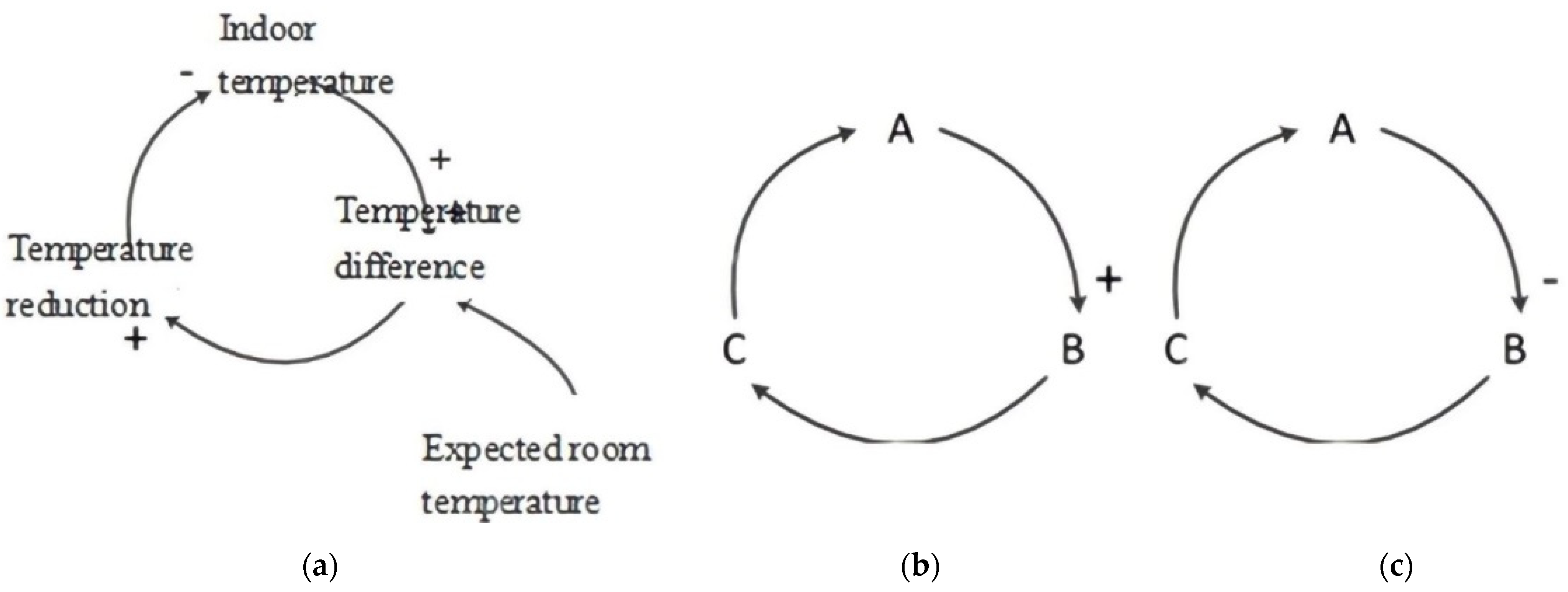
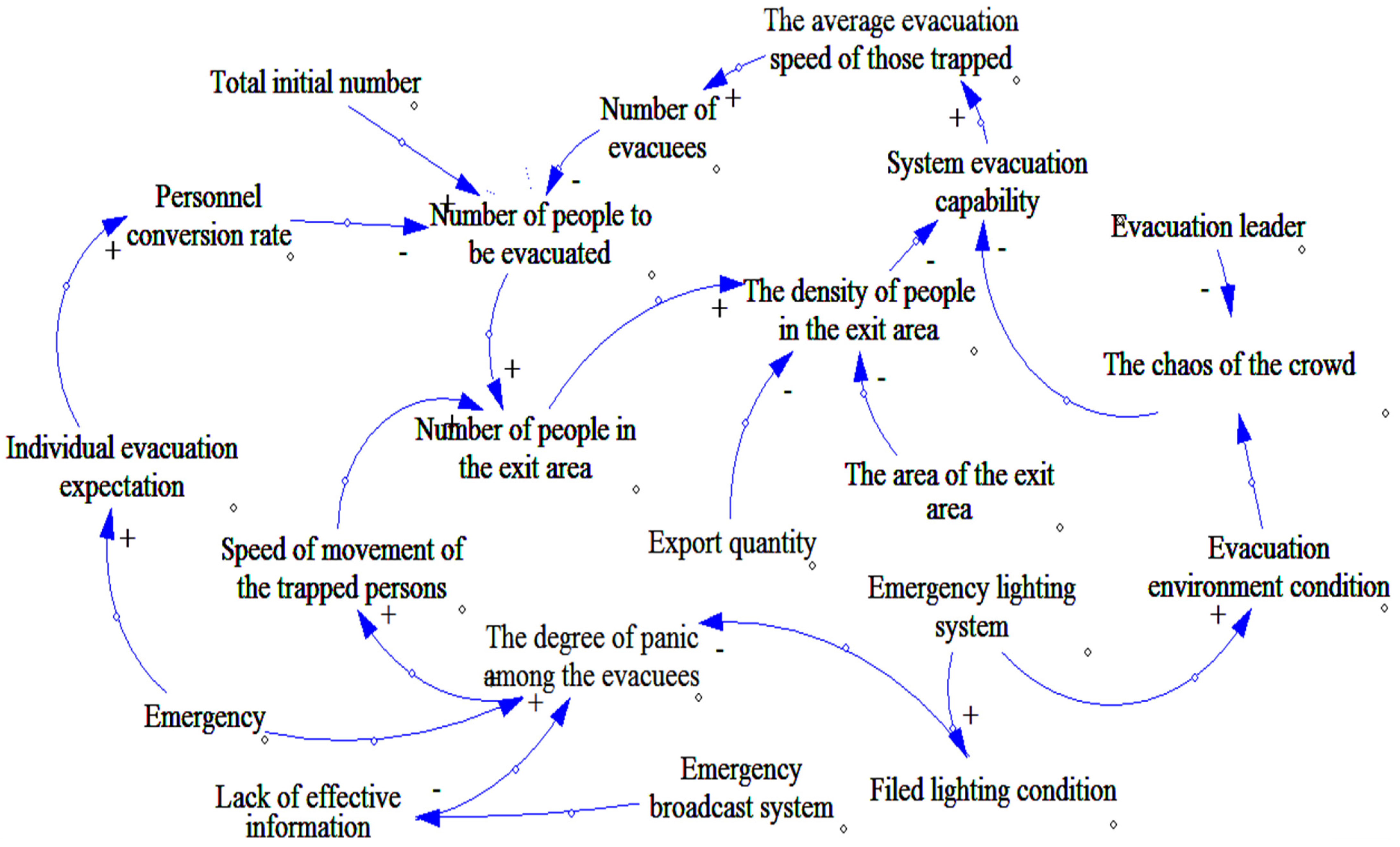


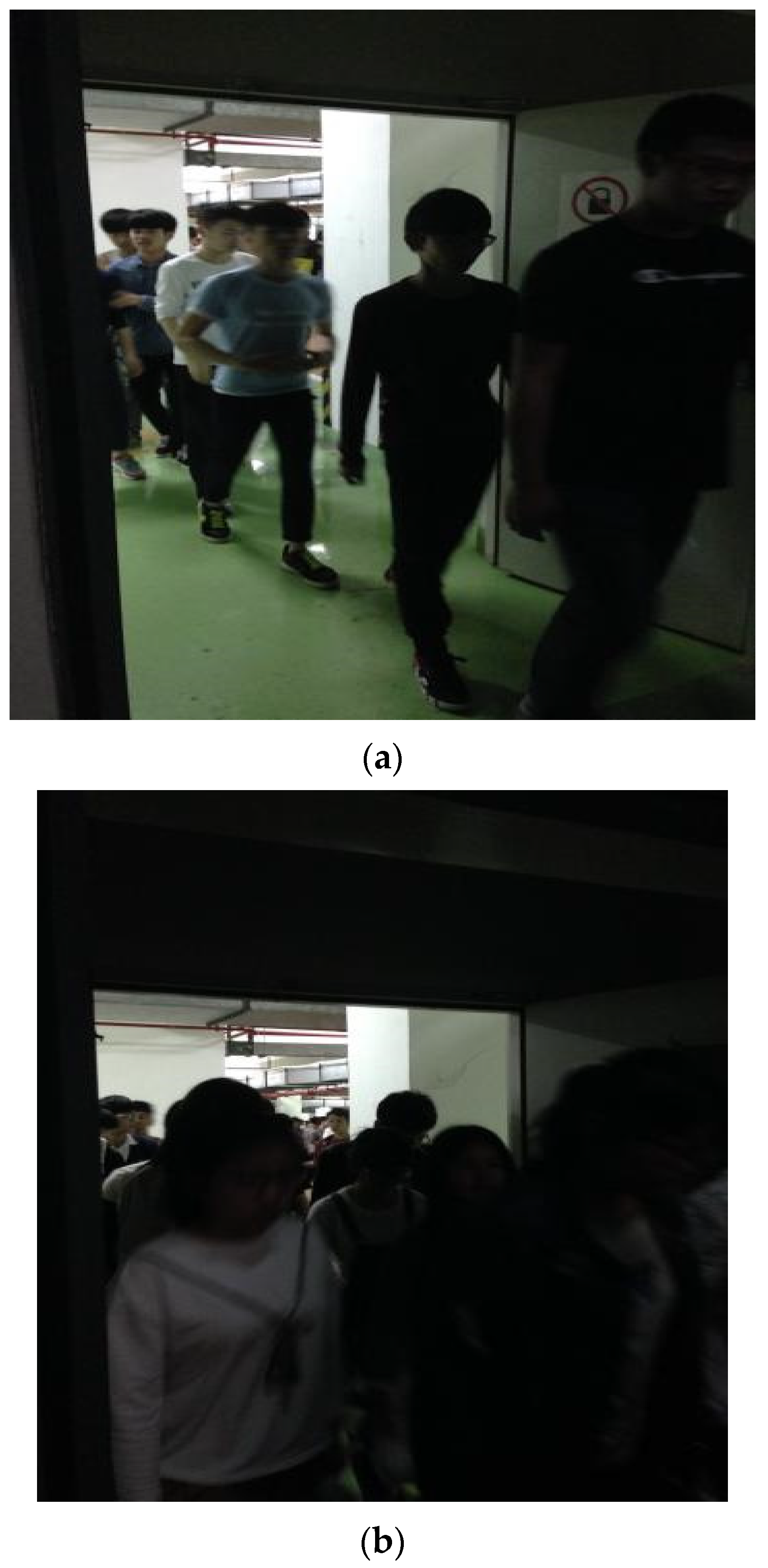






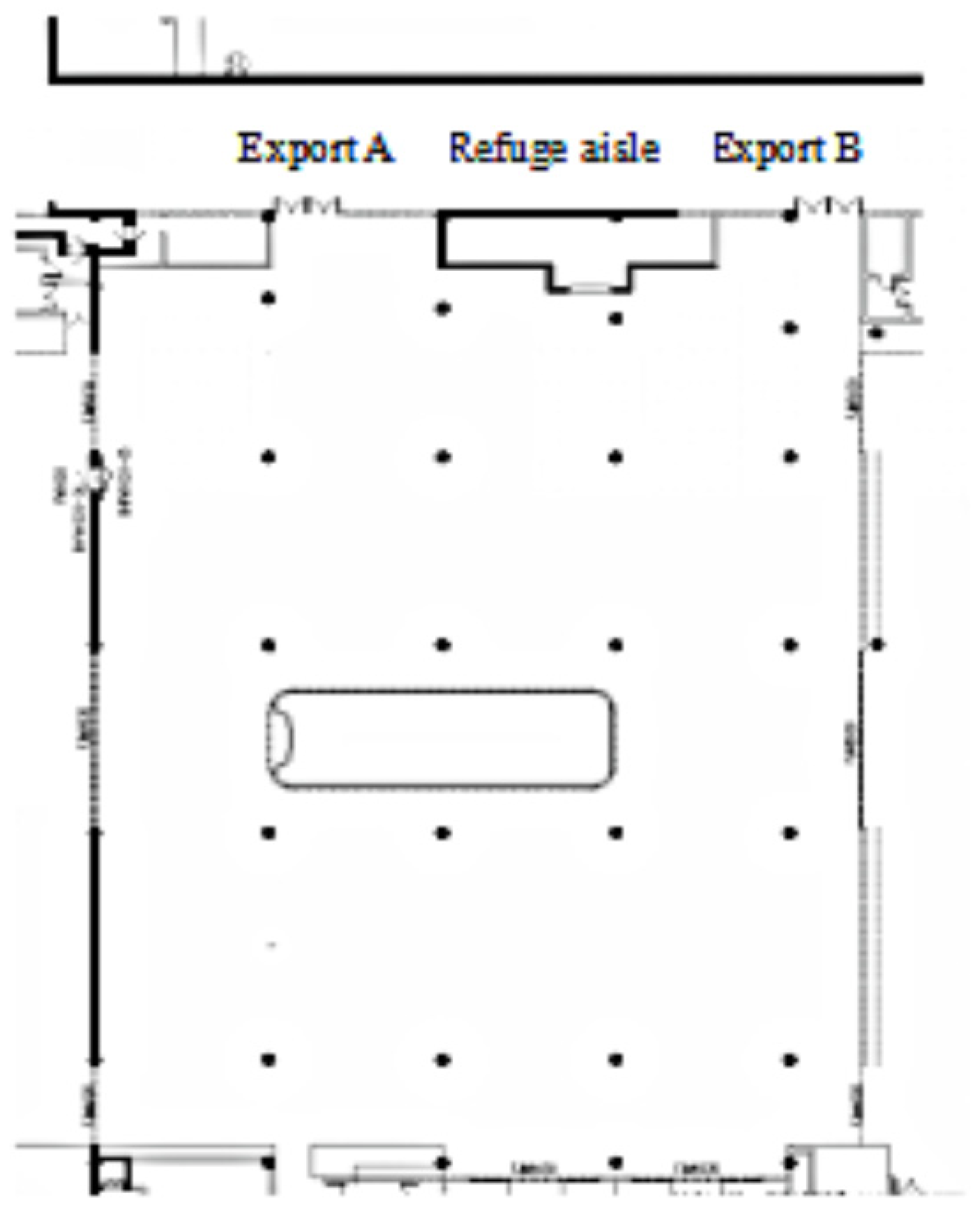



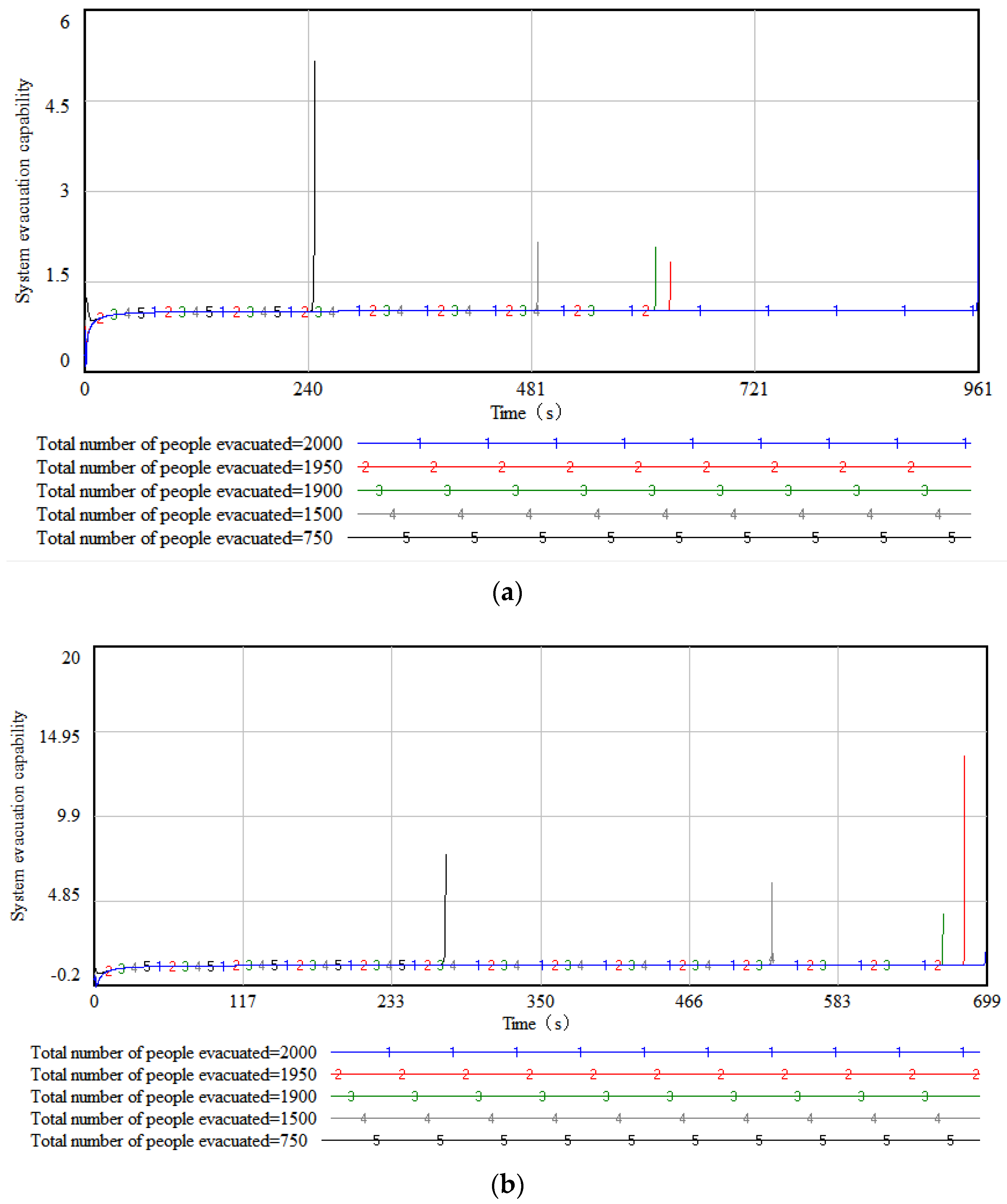
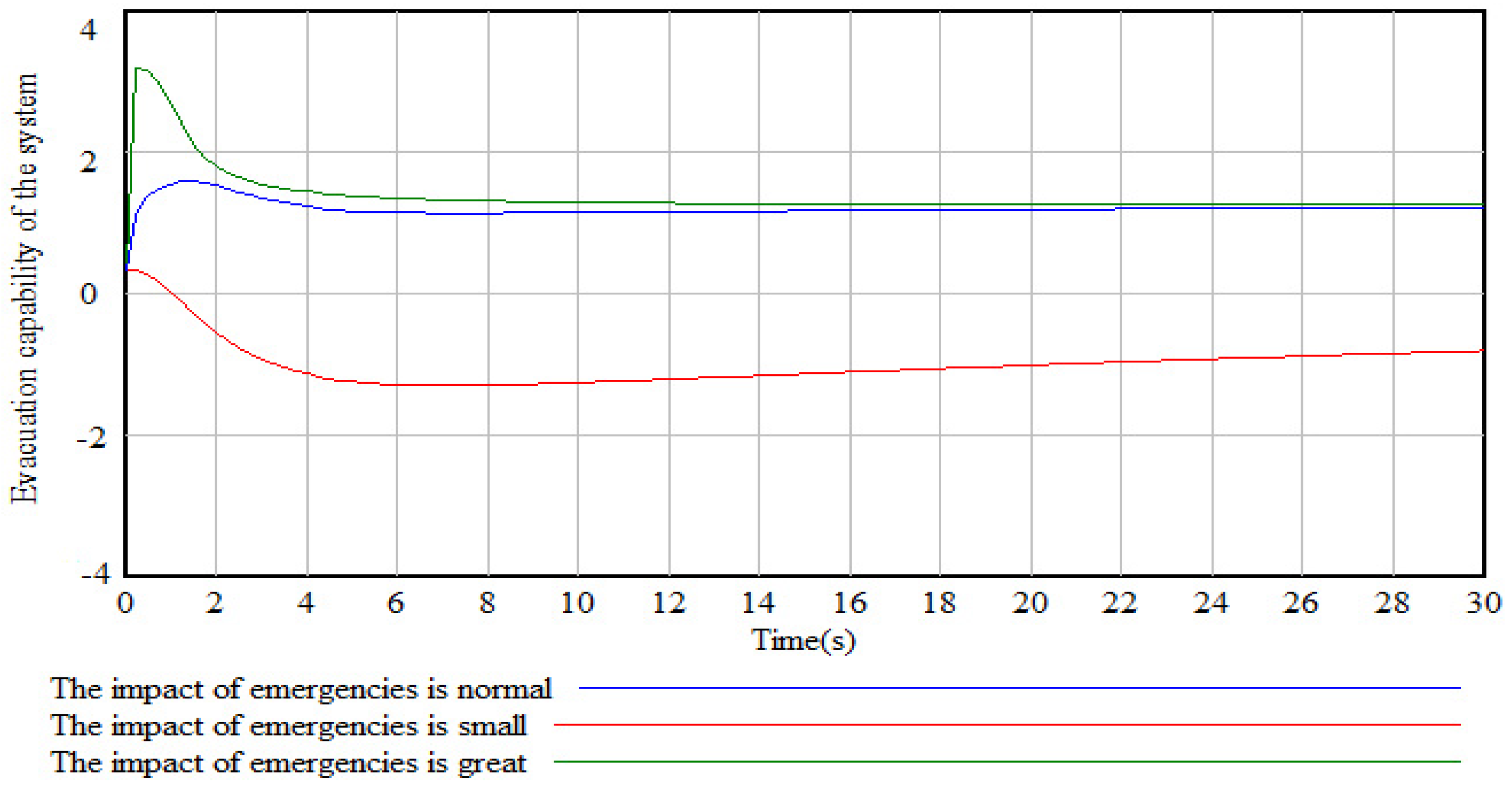


| Document Serial Number | Research Findings | Types of Models | Research Tools |
|---|---|---|---|
| [9] | Summarized the five types of the population during fire evacuation | Continuous fluid models | Database |
| [10] | Summarized the five most important components for the safety of the evacuees | Continuous fluid models | Scenario analysis and human behavioral responses were recorded by a fire video |
| [11,12,13,14,15] | Studied how evacuees can identify emergencies and respond in a fire | Continuous fluid models | Questionnaires, field visits, databases, structural equations models, empirical studies |
| [16,17] | When calculating the evacuation path, the factors of population movement changes during the evacuation were considered, and the optimal evacuation route was proposed | Continuous fluid models | Empirical studies, intelligent algorithm |
| [18] | Then, the intelligent guidance system can improve the evacuation effect | Continuous fluid models | Research databases |
| [19] | During evacuation, identification provides adequate path finding information and is critical to evacuation efficiency | Continuous fluid models | Empirical studies |
| [20,21,22] | Studied the importance that people perceive, interpret, and use the information provided by the identification system | Continuous fluid models | Empirical studies |
| [23,24,25] | Improving the effectiveness of the identification system and awareness of evacuees is critical to fire evacuation; based on technological advances, the use of modern identification systems indicates the path to the optimal exit in a clearer and simpler representation | Continuous fluid models | Intelligent algorithm, empirical studies, questionnaires |
| [26,27] | Understanding and improving people observing and interpreting signs during an evacuation can significantly improve the safety of evacuees during a fire | Continuous fluid models | Fuzzy consistent matrix, analytic hierarchy process, case analysis, micro-simulation tools |
| [29] | Complex nonlinear interactions between individuals and the environment occur, rather than a simple linear superposition, during group evacuation | Continuous fluid models | Qualitative simulation model |
| [30,31] | Complex nonlinear interactions between individuals and the environment occur, rather than a simple linear superposition, during group evacuation | Discrete models | Traditional game theory |
| [32] | Explored the interaction process between participants in the discrete evacuation model | Discrete models | Simulation of evacuation processes using a bionics-inspired cellular automaton model for pedestrian dynamics |
| [33] | Evacuation models will contain a variety of information, energy intersections, and conflicts in complex systems, leading to group trends or group confusion | Discrete models | Questionnaires |
| [34] | Large-scale group evacuation behavior is a complex social system behavior, and traditional evacuation models fail to accurately model and quantify numbers | Discrete models | Mathematical modeling, system dynamics, qualitative simulation model, case analysis, intelligent algorithm, a dynamic network flow approach considering the general laws of evacuation priority and disaster diffusion |
| Exit Distribution | Evacuation Time | Result Bias |
|---|---|---|
| Exit in the same direction | 335.1 s | / |
| Adjacent distribution of exit | 343.5 s | 2.5% |
| Exit distribution | 328.3 s | 2.0% |
| Categories | Variable Name |
|---|---|
| State variable | Number of evacuees (NE) |
| Number of people exiting (NPE) | |
| State of panic (SP) | |
| Rate variable | System evacuation capability (SEC) |
| Exit personnel growth rate (EPGR) | |
| Number of people to be evacuated (NPE) | |
| Degree of order of people (DOP) | |
| The rate at which fear increases (TRFI) | |
| Rate of reduction of personnel (RRP) | |
| Instrumental variable | Total initial number (TIN) |
| Emergency (EG) | |
| Evacuation leader (EL) | |
| Emergency evacuation lighting system (EELS) | |
| Exit quantity (EQ) | |
| Exit area (EA) |
| Variable | Types of Variables | DYNAMO Equation |
|---|---|---|
| PM | LEV | |
| EP | LEV | |
| PIS | LEV | |
| ONP | AUX | Constant; set according to different initial populations |
| EI | AUX | Constant; set to 0 (100) to indicate that no (occurrence) incident has occurred |
| EGP | AUX | Constant |
| FEI | AUX | Constant |
| PFAA | AUX | Constant |
| NOE | AUX | Constant; set according to the actual situation |
| AOE | AUX | Constant; set according to the actual situation |
| WFE | RAT | |
| IRPIS | RAT | |
| DOO | RAT | |
| ECS | RAT | |
| IRPM | RAT | |
| DOE | RAT |
| Number of Occupants | Simulated Results | Simulation Time | ||||||
|---|---|---|---|---|---|---|---|---|
| Model of This Study | Pathfinder | FDS+Evac | Model of This Study | Pathfinder | FDS+Evac | |||
| Evacuation Time | Evacuation Time | Deviation | Evacuation Time | Deviation | ||||
| 350 | 83.5 s | 88.5 s | 5.99% | 96.2 | 15.21% | 1 s | 5.1 s | 18 s |
| 400 | 98.5 s | 98.3 s | 0.20% | 106.9 | 8.53% | 1 s | 6.1 s | 20 s |
| 450 | 112.75 s | 109.8 s | 2.62% | 111.8 | 0.84% | 1 s | 7.7 s | 23 s |
| 500 | 126.75 s | 121.8 s | 3.91% | 121.3 | 4.30% | 1 s | 11.3 s | 30 s |
| 1000 | 257.5 s | 241.3 s | 6.29% | 247 | 4.08% | 1 s | 29.6 s | 181 s |
| 2000 | 510 s | 476.5 s | 6.57% | 439.3 | 13.86% | 1 s | 103.6 s | 657 s |
| 4000 | 1011.5 s | 941.3 s | 6.94% | 974 | 3.71% | 1 s | 426.2 s | 3678 s |
| Initial Number | Evacuation Time | Compliance with Regulatory Requirements |
|---|---|---|
| 300 | 67.25 s | Yes |
| 386 | 94.5 s | Yes |
| 500 | 126.75 s | No |
| 700 | 180 s | No |
| 900 | 232 s | No |
| Panic State | Value | Representation Function |
|---|---|---|
| Normal | SP | TRFI × 2 + DELAY1(IF THEN ELSE (EG > 0, 10, 0), 2) |
| Lower | SP/100 | TRFI × 2 + DELAY1(IF THEN ELSE (EG > 0, 10, 0), 2))/100 |
Publisher’s Note: MDPI stays neutral with regard to jurisdictional claims in published maps and institutional affiliations. |
© 2022 by the authors. Licensee MDPI, Basel, Switzerland. This article is an open access article distributed under the terms and conditions of the Creative Commons Attribution (CC BY) license (https://creativecommons.org/licenses/by/4.0/).
Share and Cite
Li, X.; Chen, W.; Wang, C.; Kassem, M.A. Study on Evacuation Behavior of Urban Underground Complex in Fire Emergency Based on System Dynamics. Sustainability 2022, 14, 1343. https://doi.org/10.3390/su14031343
Li X, Chen W, Wang C, Kassem MA. Study on Evacuation Behavior of Urban Underground Complex in Fire Emergency Based on System Dynamics. Sustainability. 2022; 14(3):1343. https://doi.org/10.3390/su14031343
Chicago/Turabian StyleLi, Xiaojuan, Weibin Chen, Chen Wang, and Mukhtar A. Kassem. 2022. "Study on Evacuation Behavior of Urban Underground Complex in Fire Emergency Based on System Dynamics" Sustainability 14, no. 3: 1343. https://doi.org/10.3390/su14031343
APA StyleLi, X., Chen, W., Wang, C., & Kassem, M. A. (2022). Study on Evacuation Behavior of Urban Underground Complex in Fire Emergency Based on System Dynamics. Sustainability, 14(3), 1343. https://doi.org/10.3390/su14031343








